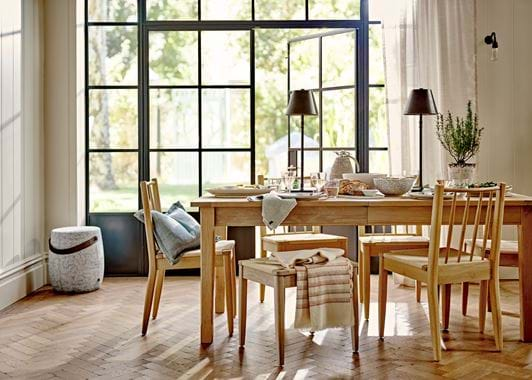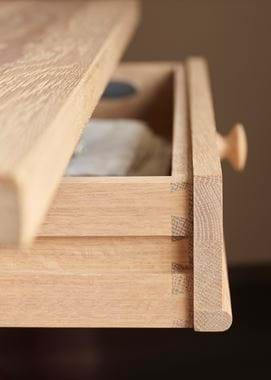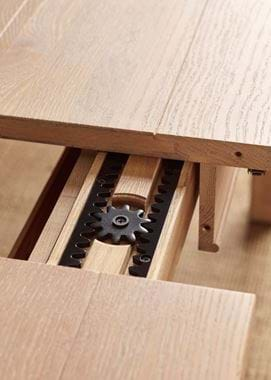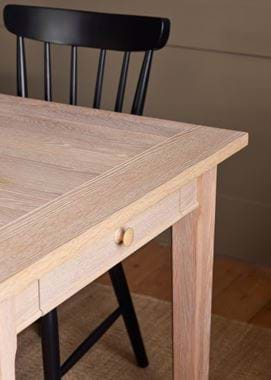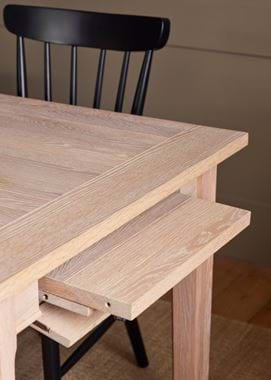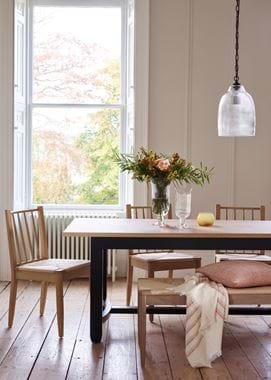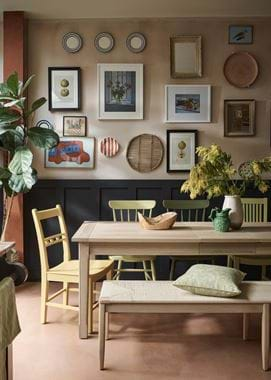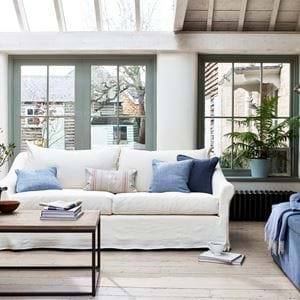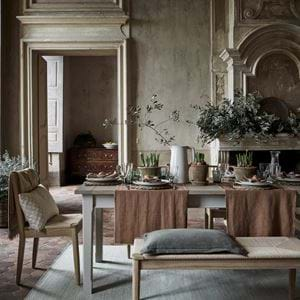The future heirloom: unpicking our Moreton table
The future heirloom: unpicking our Moreton table
There are dining tables and then there are kitchen tables, and our newest design, Moreton, is most definitely the latter – in spirit, at least, if not always in use. With its understated details, sturdy shape and practical drawers, it speaks of all things utilitarian and dependable. It’s the kind of piece that you can picture sitting at a kitchen’s heart for generations, serving as eating spot, gathering place and prep space in equal measure.
But, that’s not to say that it’s lacking in looks. Or that it’s all surface and no substance. Here, we talk to Henry, one of the designers behind Moreton, to delve deep into its character and its joinery and find out why we say – just as we can with all our designs – that this is a true heirloom piece.
The materials and finishes
“Oak’s always our go-to when it comes to furniture like tables and cabinetry,” Henry begins. “And with good reason. Oak is a slow-growing hardwood, making it particularly dense. It means that it’s less likely to dent if you knock it – anyone who’s had pine furniture or flooring will know that it quickly gets a bit bashed up.
“Then there’s the way it looks. Oak has quite a distinctive, swirling grain. It offers lots in terms of texture and surface interest, but it’s not super knotty either. Because Moreton’s quite a simple shape, we wanted to create even more interest and personality in the material, so we’ve brushed it. That’s a technique essentially a bit like sanding except that it only removes the soft fibres inside the lines of the grain. It leaves a surface that’s certainly not rough or splintering, but that isn’t perfectly slick and smooth either.”
How about the way we finish the oak? Do we do anything to protect it? “If you’re familiar with our furniture, you’ve probably heard us talking about IsoGuard® before. We’re quite proud of it! Essentially, it’s an oil that we apply to nearly all the unpainted timber in our collection. Unlike some finishes, it bonds with the timber fibres at a molecular level, providing a virtually invisible level of protection against spills, giving you time to mop them up before a stain sets in. It doesn’t make the oak shiny or affect its texture in any way. The only thing it does do is make it slightly darker, so we formulated it with pigments that reverse that effect. Moreton is finished with IsoGuard® in the Natural Oak finish, so the pigments simply return it to its natural, subtle honey colour. There’s Seasoned and Chalked Oak too, which give the timber a silvered or paler look, but the warmth of Natural felt right for Moreton.
“After we designed Moreton in top-to-toe oak, we decided to make a version with painted legs. It lets you add colour, of course, but it also brings the price down a little if you’re not quite ready for the investment of an all-oak table. You’re not compromising though – the tulipwood we use for the painted legs might be less expensive than oak, but it’s still really strong so, again, it won’t damage easily. The other reason we’ve chosen tulipwood is that it has a very fine, very even grain which is perfect for achieving a uniform paint finish. We then choose to use water-based eggshell paint because it’s not very shiny, it’s low in VOCs, and it’s easy to repaint. That last bit’s a big part of ensuring longevity too.”
The tabletop
“While we love timber, it also wants to shrink, expand and generally move around as the temperature and humidity changes. It’s a natural process, but it can be a bit of an inconvenience. So, we also use a few time-honoured techniques to counteract this, meaning that you can be sure your piece won’t warp and any movements will be tiny.
“These techniques are especially important on large, flat expanses of timber, like tabletops (the backs of cabinets are another). A solid piece of oak here would simply just move too much, and you’d end up with a tabletop that dips in the middle or the sides. So instead, for Moreton at least (other tables use different techniques), we use cross-bonded timber. When wood shrinks and expands, it does so mostly just in one direction – across the width of its grain. Cross-bonding the timber counteracts that by taking several thin planks of solid timber (usually three), and stacking them with their grains running in different directions. They’re then bonded together (using a glue that’s very strong and water-, heat- and movement-resistant, as well as a great deal of pressure). This way, when each plank tries to move, the piece next to it will be moving in the opposite direction. They’ll pull against each other and be held firmly in place.
“You could just leave the tabletop at that, but the layers of timber don’t make for the most attractive finish on the sides. So we add ‘breadboard ends’ – these solid pieces of timber are attached using mortise and tenon joints rather than simply just being glued or screwed onto the main section of cross-bonded timber. This joint allows them to ‘float’ independently of the centre panel, so if there is any tiny movement in the timber, it won’t cause problems. It’s just another solution to the dilemma of expanding and contracting that means your table will be looking as good decades down the line as it does when you buy it.”
The apron and legs
“The apron,” Henry explains, “is the section of timber that runs around the edge of your table underneath the tabletop. It’s sometimes called a ‘skirt’ too. Partly, it’s there for aesthetics: it gives the tabletop a more solid and sturdy look, and, in the case of the extending table, hides all the mechanisms and extra leaves. It’s also there for structure. If you crouch down and look underneath Moreton, you’ll spot braces in the corners – diagonally-positioned pieces of timber that are screwed into the legs, joining them to the apron and creating a sturdier table (you won’t get any wobbling from Moreton unless it’s sat on an uneven floor).”
“The apron and legs are also home to Moreton’s few decorative details. We wanted to keep this design really very simple, so it would suit the farmhouse aesthetic and also so it would last in terms of style as well as substance. But it felt too minimalist and modern – even blocky – left plain, so we added a beaded edge to the apron and ‘stop chamfers’ to the corners down the legs, so-called because they stop just short of the top and bottom (there are also routed lines in the tabletop, mimicking tongue and groove). They’re simple details, very understated, but they make all the difference in giving Moreton a more classic character.”
The drawers
“The final purpose of the apron is to surround the drawers. In non-extending designs, there are two of these, one at either end. In extending tables, there’s one normal drawer and a second false one which hides the extra leaves.”
But why include drawers in a dining table? “The drawers were actually a big part of why we wanted to design Moreton. You’ll often spot them on traditional kitchen tables – they’ve almost become a hallmark of the farmhouse style. But, more than that, they’re incredibly practical. Because we’ve positioned Moreton’s on the short ends rather than the sides, they can be really quite long. You can fit our Orford cutlery tray in with room to spare for napkins. Or you could use one to store placemats, or even to quickly tidy away homework and laptops when supper’s ready. They also make it easier to use Moreton as a prep table as much as a dining one, storing recipes, baking utensils or chopping boards inside – perfect if you don’t have room for, or you’d rather not have, an island in your kitchen.
“The drawers are made with just as much attention to detail as the rest of the table. So, although all four sides are made from solid oak, the bottom is a sturdy sheet of oak-veneered plywood because, being a larger expanse of timber, it would warp if it was solid. The sides of the drawer are also joined together using dovetail joints – these look like teeth that slot together like a jigsaw, and because the teeth splay out, they’re not going to slip apart when you pull on the drawer. We’ve then added on a separate drawer front to the drawer box so the dovetails are hidden and the front sits (nearly) seamlessly into the apron. We’ve even given it the same beaded detail. Then, when you pull the drawer out, you’ll see traditional wood-on wood runners on the sides, rather than metal ones that would slightly spoil the look. You also can’t pull the drawer too far out or push it too far in by accident because there’s a discreet wooden stopper. They’re little details, but we think they make all the difference to how enjoyable Moreton is to use and how long it’ll last.”
Extending Moreton
“Extending tables are great, but only when they’re not a pain to use. So we really considered how the extending version of Moreton would work – something we’ve done with all our other designs too,” explains Henry. “Firstly, because Moreton has an apron, we could hide the extra leaves within its construction, rather than needing to store them separately. Simply flip down the false drawer (which is on hidden hinges) and they’re sitting behind there. Pull as many as you need out, set them to one side and close up the ‘drawer’ front. Then, you unlatch the tabletop from underneath and pull either end apart. The extra leaves then slot into place using bronze-coated metal pins and latches. The leaves even have their own aprons – which are on hinges too so they can store flat – to fit in with the tabletop’s. And it’s as simple as that.”
Explore all our dining tables, including Moreton, online here.

